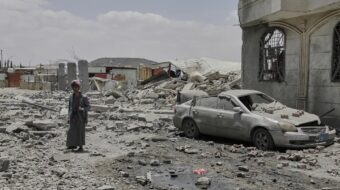The catastrophic effects of the Dec. 26 earthquake in Bam, Iran, and the surrounding areas are enormous. Eighty percent of the city has been destroyed, with at least 30,000 dead (some say this figure could reach 50,000) and more than 100,000 homeless.
Given the widespread poverty in Iran and lack of effective assistance from government authorities, many of the survivors are currently facing hunger, destitution, and death.
The disaster has exposed major structural weaknesses in the country’s emergency rescue and recovery operations. According to many eyewitnesses, the rescue has been chaotic and ineffective. The tragedy has also revealed the extent to which Iran’s construction companies have evaded codes that make buildings more earthquake-resistant.
Obviously, dealing with a disaster of such magnitude is a challenging undertaking. Thousands of Iranian volunteers and many international aid agencies rushed in to help. This has been accompanied by a deep sense of grief and massive support and donations given by ordinary people in Iran.
The number of popular initiatives to organize volunteers, to raise funds and to collect urgently needed supplies is unprecedented.
By way of contrast, the ruling theocratic regime initially tried to deal with the tragedy by maintaining silence. Further, because of the regime’s fear of a political backlash in Bam, it initially barred nongovernmental rescue teams from other parts of Iran, and even international teams, from going there. It finally relented and let them in.
Nonetheless, the regime’s endemic corruption and structural mismanagement are well known, and many Iranians fear that all of the aid will not reach those in need.
Other fundamental questions are being raised and angrily discussed among the people and in some of the reformist papers: Why is it that in Iran so many natural disasters frequently turn into horrifyingly large tragedies? Why in many other parts of the world a 6.5 Richter-scale earthquake leads only to a small number of casualties, but in Iran a similar earthquake can wipe out an entire city? Why in a country so rich with natural resources as Iran are the authorities so incapable of reducing the scale of the casualties?
Property ownership and building construction are among the most lucrative activities in Iran. Both are dominated by the private sector and powerful organizations with strong links to the regime’s elite. With a culture of corporate greed and a rush to turn a quick buck, safety measures and regulations are usually ignored through bribery and corruption.
Widespread evasion of preventive, anti-earthquake building codes obviously contributed to the death toll. Not only traditional, mud-walled houses collapsed, but new buildings – such as hospitals and government office complexes – were also devastated.
Many people understand that the severe consequences of these natural disasters are man-made. They know the root cause of the problem is the ruling regime in Tehran. This is why President Mohammed Khatami’s pledge to rebuild a new Bam within two years is ridiculed as another hollow promise. Similarly, Supreme Leader Ayatollah Ali Khamenei’s pledge to restore the city to its former glory evokes widespread disbelief.
Undoubtedly the political aftershock of Bam’s earthquake will further intensify the Iranian people’s outrage toward the tyrannical regime.
Bam’s tragedy has led to a sudden conciliatory overture by the U.S. administration towards Iran’s regime. Obviously, humanitarian aid, reductions in tension and a change in the aggressive militaristic behavior of the Bush administration are to be welcomed.
But Secretary of State Colin Powell says he sees “the beginnings of a new attitude in Iran.” Powell’s statement raises the question: What change in attitude is he speaking about?
As far as the Iranian people and the progressive forces can see, this regime is still obstructing any efforts towards democratic changes. And its neoliberal economic policies, combined with high-level corruption, are intensifying poverty and misery across the country.
The ruling dictatorship in Iran is extremely unpopular and is facing a growing challenge from a popular movement for democracy. It is seeking a way out of its current crisis – internally, by repressing the democratic movement, and externally, by expanding its diplomatic ties with the U.S. and British governments.
The U.S. has a policy of propping up undemocratic regimes. The tragedy in Bam may have inadvertently provided a window of opportunity for a “compromise” between the Bush administration and the regime in Iran.
Nima Kamran is a correspondent from the Tudeh Party of Iran and can be reached at pww@pww.org.









